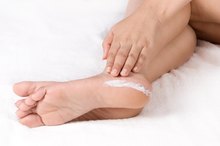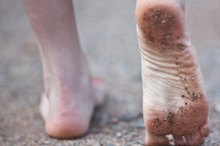What does fact checked mean?
At Healthfully, we strive to deliver objective content that is accurate and up-to-date. Our team periodically reviews articles in order to ensure content quality. The sources cited below consist of evidence from peer-reviewed journals, prominent medical organizations, academic associations, and government data.
The information contained on this site is for informational purposes only, and should not be used as a substitute for the advice of a professional health care provider. Please check with the appropriate physician regarding health questions and concerns. Although we strive to deliver accurate and up-to-date information, no guarantee to that effect is made.
Salicylic Acid & Heel Cracks
Salicylic acid is a topical medication used to treat a variety of skin conditions, including psoriasis, acne, dandruff, warts, corns and calluses 1. It is also sometimes used as a preventive treatment for cracked heels, a condition characterized by abnormal splits or fissures in the skin at the rear of your feet.
Salicylic Acid Basics
Salicylic acid belongs to a group of medications called keratolytic agents, according to the U.S. National Library of Medicine’s Medline Plus website 1. When used to treat conditions other than acne, it achieves its effects by loosening and softening skin that is thickened, dry or scaly. This skin then becomes easier to remove or falls off on its own. Salicylic acid comes in both prescription and nonprescription formulations 1. Available types of these products include:
- gels
- ointments
- creams
- lotions
- liquids
- patches
- wipes
- pads
Heel Crack Basics
When to See a Podiatrist for Cracked Heels
Learn More
You can develop cracked heels for a number of reasons, according to the New Zealand Dermatological Society 2. Common underlying causes include prolonged or habitual standing, obesity or excessive body weight, habitual wearing of sandals or open-backed shoes and the presence of abnormally dry skin, corns or calluses. You can also develop cracked heels if you have any one of a number of medical conditions, including palmoplantar psoriasis, atopic dermatitis, juvenile plantar dermatosis and palmoplantar keratoderma.
Heel Crack Formation
In some cases, a developing callus may appear dark brown or yellow in color. If you don’t treat a heel crack in its early stages, it can deepen and cause disruptive amounts of pain. In some cases, cracks may penetrate deep enough to trigger heel bleeding. Untreated cracks can also become infected, leading to a serious condition called cellulitis. If you have diabetes, an untreated heel crack can lead to another serious condition called a diabetic foot ulcer.
- In some cases, a developing callus may appear dark brown or yellow in color.
- In some cases, cracks may penetrate deep enough to trigger heel bleeding.
Crack Prevention
How to Fix Cracked Heels
Learn More
You can help prevent a cracked heel or stop an existing minor crack from worsening by regularly applying a moisturizing cream or heel balm that contains salicylic acid, the New Zealand Dermatological Society reports 12. Use of these products will keep your heel skin properly hydrated and diminish the conditions that make a heel crack possible. If you catch a crack in its early stages of formation, you may be able to resolve it by applying a moisturizer two or three times a day. In addition to salicylic acid, effective heel crack products may include the active ingredients alpha-hydroxy acid, saccharide isomerate or urea 1.
Considerations
If your skin is already broken, you should not apply salicylic acid, Medline Plus reports 1. Also avoid applying salicylic acid to skin that is infected, reddened, swollen or irritated 1. Once you apply salicylic acid to your skin, do not cover it with any type of dressing or bandage without your doctors explicit instructions 1. Do not put a salicylic acid-containing product on normal skin 1. Follow the instructions included with your product and consult your doctor for additional information.
Related Articles
References
- Medline Plus: Salicylic Acid
- The New Zealand Dermatological Society: Cracked Heels
- Arif T. "Salicylic acid as a peeling agent: a comprehensive review." Clinical Cosmetic and Investigational Dermatology. 2015 Aug; 8:455-61.
- Arif T. "Salicylic Acid as a Peeling Agent: A Comprehensive Review." Clinical Cosmetic and Investigational Dermatology. 2015 Aug 26;8:455-61.
- Castillo DE, Keri JE. "Chemical Peels in the Treatment of Acne: Patient Selection and Perspectives." Clinical Cosmetic and Investigational Dermatology. 2018; 11: 365–372.
- Zaenglein AL, Pathy AL, Schlosser BJ, et al. "Guidelines of Care for the Management of Acne Vulgaris."Journal of the American Academy of Dermatology. 2016 May;74(5):945-73.
Writer Bio
M. Gideon Hoyle is a writer living outside of Houston. Previously, he produced brochures and a wide variety of other materials for a nonprofit educational foundation. He now specializes in topics related to health, exercise and nutrition, publishing for various websites.








